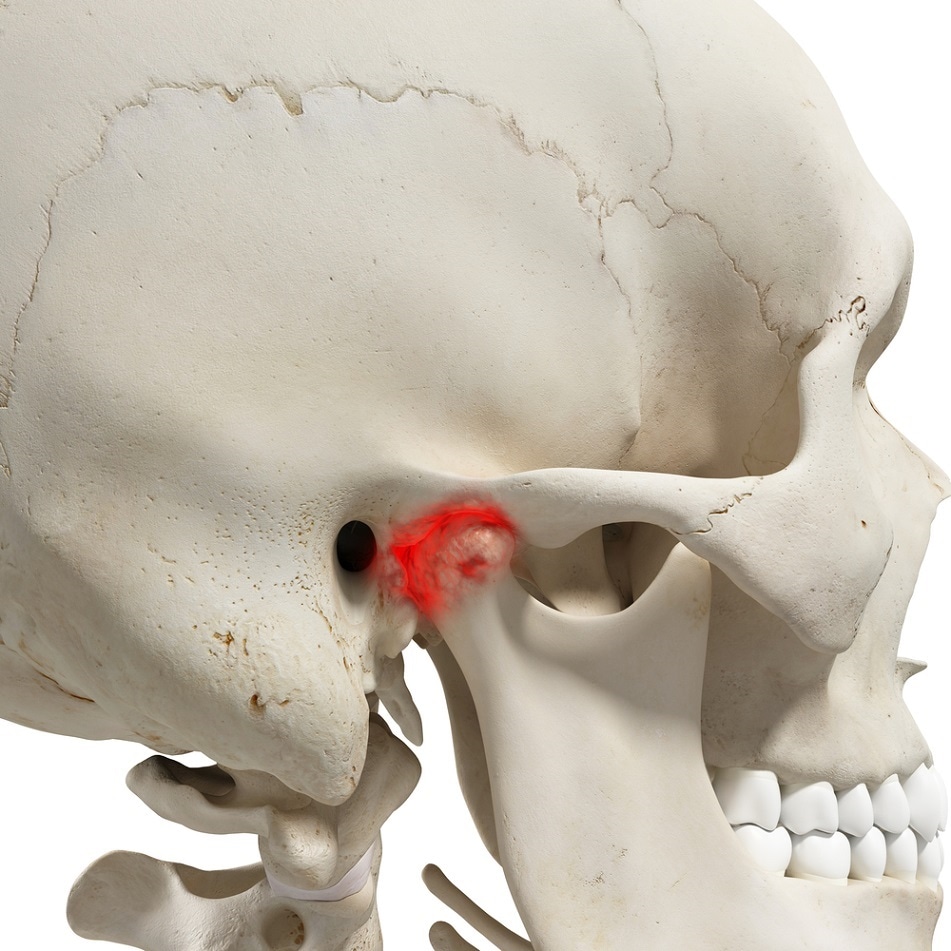
TMJ disorders could be treated with tissue-engineered implants after successful animal study
It’s estimated that around 10 million Americans experience a temporomandibular joint (TMJ) disorder, with women being more susceptible than men. Affecting the jaw joint, TMJ disorders are characterized by pain around the jaw, ear, and temple, as well as difficulties in opening the mouth and significant clicking or grinding noises brought on by jaw movement.

Shutterstock | Sebastian Kaulitzki
Despite the high incidence rates of the disorders, there are not many treatments and cures that go beyond palliative measures.
Kyriacos A. Athanasiou, Distinguished Professor of biomedical engineering at the University of California, Irvine, is the senior author on a paper recently published in the Cell Press journal Trends in Molecular Medicine. The paper investigates why temporomandibular disorders occur, interrogates failures in treating the disorders in the past, and looks at novel approaches to treating the disorders. These new approaches include using tissue-engineering innovations from his own laboratory.
Senior co-authors are Ryan Donahue, a UCI graduate student researcher in biomedical engineering, and Jerry Hu, UCI principle development engineer in biomedical engineering.
Athanasiou explained the effects of TMJ disorders on daily life.
“The TMJ is central to chewing, talking and so many other daily activities, so when this crucial joint is impaired, there are significant negative effects on quality of life.
“The problem may start with slight pain and clicking and get progressively worse to the point where it’s not just impacting the jaw but the entire body.”
TMJ disorders can occur after an injury, natural wear to the joint over time, or an uneven bite. Anxiety disorders and stress can also result in a temporomandibular joint disorder through increased, subconscious clenching of the jaw both during the day and while a person is asleep. Typically, problems with the jaw joint in these disorders are due to thinning or perforation of the disc between the mandible and temporal bone.
Athanasiou describes a “TMJ gender paradox” in a book published in 2009 called Tissue Engineering of Temporomandibular Joint Cartilage, with reports stating that female-to-male patient prevalence varies from 3:1 to 8:1. It also says that pain onset in TMJ patients is most prevalent in women between the ages of 20 to 40 years old.
On the merit of tissue engineering as a new approach for treatment, Athanasiou states in the book that the “lack of an intrinsic regenerative ability in cartilaginous tissues renders them ideal candidates for tissue engineering approaches.”
Treatments for TMJ disorders are lacking despite the joint being similar to many others in the body, like the knees, elbows, hips, and shoulders, for example, for which there are many treatments for cartilaginous disorders.
Athanasiou explains why there are so few operations carried out on the jaw.
“It has to do with the proximity of the TMJ to the brain,” he said. “Back in the 1980s, many patients – primarily women – came forward with issues they had with the TMJ. The solution at the time was to insert a spacer between the two bones articulated in the jaw.”
This particular spacer was made of Teflon, a synthetic resin that has been approved by the US Food and Drug Administration (FDA).
“It turns out that Teflon was an absolute disaster for all of those women,” Athanasiou continued. “Because of the large mechanical forces generated by the jaw, the Teflon broke up into pieces, and because of the proximity of the TMJ to the brain, those pieces somehow found their way into the brain.”
In Tissue Engineering of Temporomandibular Joint Cartilage, Athanasiou describes how the catastrophic failures of the 1980s Teflon treatment for TMJ have “tainted all forms of TMJ surgery and discouraged many surgeons from seeking alternative methods to reconstruct the joint.” He also points out that “despite the immense suffering” the patients affected by failures in the Teflon treatment, the “lessons learned from this experience are essential.”
The new treatments Athanasiou and his team do not use synthetic materials at all, instead involve developing biological TMJ discs that will be suitable for use in humans.
“The end product that we aspire to use for treating afflictions of TMJ discs is a tissue-engineered product that’s fully alive, biological and mechanically comparable to the real thing,” Donahue said. “So even if it breaks down, it will be like any other biological component, without having pieces of foreign material entering the brain.”
Results from work carried out by Athanasiou’s research team were published in Science Translation Medicine in 2018. Their work saw them successfully grow cells from the rib cartilage of a Yucatan miniature pig and implant the tissue-engineered construct into another animal.
Contrary to many methods used by researchers, which would see the bioengineered cells placed in another part of the animal’s body, Athanasiou emphasized the importance of placing the new disc in exactly the same place from where they were taken from the first animal. This is so the new disc will experience the same natural stresses of the joint.
Hu elaborated on the success of the implantation:
“In eight weeks, we saw complete functionality of the TMJ disc, whereas the ones we left untreated deteriorated completely, developing full osteoarthritis in the joint.
“So we were able to show that by using our tissue-engineering approach in a large-animal model, we could achieve exceptional healing.”
Goals for the future include carrying out further trials in other large animals to ascertain if this particular treatment would be suitable for humans. Although there were concerns about having their treatment approved by the FDA, Athanasiou says:
“The FDA has asked if we could help them figure out how to go about developing processes for bringing TMJ products to the market.”
He goes on to say that they would be “delighted to help create that pathway.”
Sources:
- https://books.google.co.uk/books?id=HYpiAQAAQBAJ&pg=PA22&lpg=PA22&dq=TMJ+gender+paradox+athanasiou&source=bl&ots=wdxqvuuTeJ&sig=ACfU3U2NGsGeRMvRkKCAq7FqrQ6nLyOqNA&hl=en&sa=X&ved=2ahUKEwjbiNW89ZLhAhXisHEKHaaVBZAQ6AEwBHoECAkQAQ#v=onepage&q=TMJ%20gender%20paradox%20athanasiou&f=false
- https://www.eurekalert.org/pub_releases/2019-03/uoc--uea032019.php
- https://www.nidcr.nih.gov/health-info/tmj























.png)











No hay comentarios:
Publicar un comentario